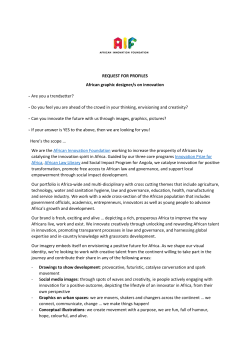
African Diasporic Foodways
African Diasporic Foodways: A Deeper Look for ATOAH Teachers What is the African Diaspora? Diaspora means dispersal or scattering of a group of people from their original homeland. Therefore the African Diaspora is defined as the geo-‐political areas where people of African descent have resided after involuntary removal from Africa. The African Heritage Diet celebrates the eating patterns, foods and cuisines of the four major regions of the African Diaspora: Africa, Latin America, the Caribbean and the American South. The African Diaspora also includes parts of Central America, Canada, Great Britain, Pakistan, and India – places where large populations of African descendants settled post enslavement. Just as people moved throughout the world to create the African Diaspora, so did their foods and foodways. Food, typically in the form of seeds, was transported with enslaved Africans to different parts of the globe. Along with those seeds was the preservation of food traditions through recipes, cooking and storage techniques, and agricultural knowledge. This history is still very much alive with us today in the way we grow foods, prepare foods, and share foods! African Heritage Cuisines The major regions mentioned in the A Taste of African Heritage curriculum are home to some of the largest populations of African descendants in the African Diaspora: AFRICA Africa is extremely diverse—both culturally and geographically. There are 53 countries in Africa and over 1,500 different languages. The culinary diversity in Africa has been shaped through geography, climate, trade, and cultural influences for centuries. North Africa North Africa is just a boat ride away from Europe, across the Mediterranean Sea, and includes Morocco, Algeria, Tunisia, and Libya. Occupations by France, Spain and Great Britain left very little impact on the food and cultures of North Africa. Historically, Arab presence and Islamic culture have dominated North Africa, powerfully shaping the area’s food traditions. Arab influences include the heavy use of spices like saffron, nutmeg, cinnamon, ginger and cloves that define this region’s flavors. Because the region is predominantly Muslim, halal meats are typically served (halal meats are derived from animals slaughtered according to Sharia, Islamic law). Couscous, tajine dishes, olives, dates, almonds, fresh herbs like mint, and spiced lamb dishes are a few of the emblematic foods found along North Africa. To the northwest, Egypt’s food and culture have much in common with their neighbors in the Middle East. Falafel, pigeon peas, broad beans, spiced breads, and beer are just a few of the foods with ancient Egyptian roots. West Africa West Africa is comprised of 17 countries: Mauritania, Senegal, the Gambia, Guinea, Guinea-‐Bissau, Sierra Leone, Liberia, Cote d’Ivoire, Mali, Burkina Faso, Ghana, Togo, Benin, Nigeria, Niger, Cameroon , and Cape Verde. Except for the outmost northern areas, West African countries share a similar tropical savannah climate, ecology, culinary traditions and history – including the Transatlantic Slave Trade. “Much of the slave trade was based in West Africa, “ explains Marcus Samuelsson in his beautiful cookbook The Soul of A New Cuisine, “these slaves carried their culinary traditions with them, introducing native foods such as okra, black-‐eyed peas, sweet potatoes, watermelon and sesame seeds to the faraway lands they were taken to.” Samuelsson includes five additional countries not usually categorized as West African, but which share common culinary threads—Chad, Central African Republic, Equatorial Guinea, Gabon, and Sao Tome & Principe. These threads include simple meals based on a starch, a stew and vegetables. Common scenes throughout West Africa might include fish being cooked in banana leaves, or giant mortars and pestles of mashed groundnuts (peanuts) for Mafe stew or yams for fufu. Chiles are present throughout West African cuisines, especially in southern Nigeria, where the food is “blisteringly hot” according to Samuelsson. East Africa East Africa is the picturesque landscape we often think of when we think of Africa: dramatic savannahs, tropical rain forests, and exotic wildlife like gazelles, zebras, cheetahs and elephants span this region. Indian and Arab traders contributed to the traditions, cultures and cuisines of East Africa. As early as 700 A.D., Arabs from the Arab Peninsula intermarried with native East Africans, which is physically present in the populations of Ethiopia, Sudan and Madagascar. Arab traders brought their spices and cooking techniques with them, including steamed rice served with saffron, cinnamon and cloves. Indian traders left an even greater mark on the cuisines of this region, introducing curries, spice blends, and breads to the foods of the region. Ugali, a thick porridge made from cornmeal or millet, is the most common food staple throughout East Africa, and the underpinning of many meals. Injera, a spongy sourdough flatbread made from the whole grain teff, is the staple in Ethiopia. Injera is served with most meals, accompanying a rich variety of meat, fish and vegetable stews (called “wats”). The injera is used to pinch scoops of food, eaten with one’s hands. Southern Africa With eleven countries making up the region known as Southern Africa, this region is home to an array of ecologies: forests, grasslands, mountains, and deserts, which, of course, are home to a rich variety of food! Southern Africa includes the Republic of South Africa plus Angola, Botswana, Lesotho, Malawi, Mozambique, Namibia, Swaziland, Tanzania, Zambia and Zimbabwe. Traditional cooking of Southern Africa has been shaped by African tribal societies, as well as European and Asian descendants. The indigenous people of Southern Africa include the Bantu-‐speakers, who arrived to the region approximately 2,000 years ago, and the Khoisan people, who have lived in the region for at least 10,000. The Khoisan people were hunter-‐ gatherers, eating wild animals, tubers and foraged vegetables. The Bantu-‐speakers raised cattle for milk and meat. The tradition of roasting meat in these societies was a precursor to Southern Africa’s love of barbecue, called “braai” in Afrikaan. Due to colonization and settlement there are sizable Dutch, British, Portuguese and South Asian populations present in this region and this has added a complexity to the food and foodways to this area. Countries like Namibia has German-‐influenced food, while Lesotho offers a variety of potato-‐based dishes because of the British legacy. Many of the spices used in Southern Africa’s cuisine, such as curry and nutmeg, used in the cooking of this region comes from South Asia.. Throughout Southern Africa, staple ingredients include: corn, squash, yams, pumpkin, papaya, apples, mangoes, avocado, apricots, and small dried fish. Beer is a staple beverage in Southern Africa, including traditional maize (corn) beer and Eurpoean-‐style lagers. CARIBBEAN The Caribbean islands are also a fusion of cultures, bearing many countries with large African descendant populations as a result of the Transatlantic Slave Trade. Afro-‐Caribbean people are Caribbean inhabitants who trace their heritage to Sub-‐ Saharan Africa. Other names for this group include African-‐Caribbean, Afro-‐ Antillean or Afro-‐West Indian. Caribbean countries with the largest African descendant populations include Haiti, Dominican Republic, Cuba, Jamaica, Puerto Rico and Trinidad and Tobago. Native Africans, mainly from West Africa, brought their cooking techniques and flavors with them to the Caribbean islands. They borrowed ingredients from the existing cultures there in order to create delicious dishes enjoyed today. With the help of African influence, the Caribbean is well known for dishes built on curries, stews, rice and peas, green bananas and plantains, cassava, and drinks made from fresh juices and locally grown flowers and mosses. Some people are surprised to learn that Caribbean-‐based traditions such as the Shango Baptist religion of Trinidad and world famous Carnival are historically African. LATIN AMERICA Brazil has the largest Black population outside of Africa in the world. Although Brazilians speak Portuguese, having been colonized by the Portugal in the 1500’s, culturally Afro-‐Brazilians are greatly linked to the continent of Africa. Music and dance such as samba, and spiritual traditions such as the largely practiced Candomble’ are by in large African traditions. Colombia has the second largest Black population in Latin America and Venezuela is said to come in at third. Throughout Spanish speaking Latin America, there are large African descendant populations living on the coasts, where their enslaved African ancestors were brought on ships during slavery – places like Costa Rica, Nicaragua, Belize, and Honduras. Most of these descendants never left the area, and their contributions to Latin America’s culinary traditions continue. Black-‐eyed peas, palm oil, okra, chili peppers, dried fish, and banana leaves are just some of the ingredients brought from African to Latin American cuisine. Enslaved African families were often given less desirable cuts of meat, like the shoulder and intestines. These families developed ways of cleaning and seasoning offal to make it palatable, creating new traditional foods born from necessity and ingenuity. AMERICAN SOUTH Many are surprised to learn that the smallest number of Africans was brought to the United States within the Translatlantic Slave Trade. However, just like in other places throughout the African Diaspora, Africans brought so much with them to incorporate and reinvent in the southern part of the U.S. Since agriculture was most prominent in the southern states during slavery, Africans were brought primarily to these areas to put their expertise to work. Africans who were captured were the skilled artisans and laborers, so they were able to cultivate the land in prosperous ways. For example, the irrigation and cultivation of rice farms in the Southeast U.S. would not have been possible without the wisdom and skills of African laborers. Red rice, collard greens, sweet potatoes, and stewed okra are just a few of the many soul and southern food ingredients sprung directly from Africa. Just as in other regions of the African Diaspora, African culture was maintained in all areas of African American life, such as in music – you see African influences in jazz, soul, funk, and gospel – as well as through dancing traditions like the ring-‐shout and stepping, and spiritual practices. African Heritage Agricultural History The rich agricultural history of the continent of Africa speaks to the healthy and fresh foodways that Africans and their descendants have always embraced. Eating what you grow is key. The old ways of growing and eating food around the world involved eating seasonally and locally. Foods were planted, grown, and harvested in different seasons for the freshest tastes possible, and Africans and their descendants throughout the African Diaspora knew this. Only a few generations ago, food was grown by farmers you knew in your community, so you knew exactly where your food came from. Today’s farmers markets and community gardens harken back to the healthy, quality-‐driven traditions of our great grandparents. Visiting these types of markets in our communities helps to keep these traditions alive. If there Whole grains, plant-‐based foods like vegetables and beans, and hearty tubers ruled the plate. The Nutrition Shift Further Like most populations, African Americans have greatly gotten away from their agricultural-‐based heritage today. With processed foods occupying the majority of our kitchen cabinets, most Americans are not consuming enough fresh and whole foods. The move away from fresh, plant-‐based meals to fast, packaged and highly processed foods, high in sodium, sugar and unhealthy types of fat, has shifted the health of the African Diasporic community tremendously. African ancestors did not suffer from the escalating rates of obesity, high blood pressure, cancer, and other diet-‐related health issues we see today. Their traditional diets and lifestyles, comprised of fresh foods and more physical exercise, helped protect them from such lifestyle related conditions. The Taste of African Heritage program aims at to bring these healthy traditions back to the table. Science shows that a diet of herbs and spices, fresh fruits and vegetables, leafy greens, beans, nuts, tubers, and little meat and dairy, can help everyone lead a healthier life. This program incorporates the amazing flavors, health-‐promoting foods, and culinary histories from the beautifully diverse regions of the African Diaspora in order to help showcase its health benefits to all. Thank you for doing your part!
© Copyright 2025









